Edward E. Brickell Medical Sciences Library
I first became acquainted with this library twelve years ago when my son was in the Pediatric Intensive Care Unit at CHKD next door. When you’re in the PICU for nearly four months, you wander. You can’t go too far but you can’t stay in the hospital all the time either. So, in the dead of winter, usually in the middle of the night, I would stand outside this library and stare up at it and wonder if somewhere in there was the answer that was going to bring my kid home. I even tried the door a few times but it was always locked. Maybe it was a metaphor. Or maybe, as I discovered on a recent visit, only one set of the doors is actually unlocked. Once my son was transferred to Boston Children’s Hospital I would do the same thing at Harvard Medical School next door. Talk about aww (Ettarh 2018). And so began my love/hate relationship with the medical resource libraries.
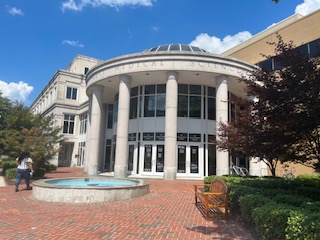
This library is “open to the public” but not in a “the public actually knows” sort of way. After trying five sets of doors that were all locked, I was met by an EVMS student who’d forgotten her badge and knew enough to knock on the door and ask the guard for admission. I would not have done that on my own and, probably, neither would the average person. The guard let us in and we showed ID and signed in. Again, not very “public” in my opinion.
This library is so quiet it’s like the air itself has been removed from the building. The first floor has a reference desk, a few study areas and a Lay Health Medical collection, and I can’t help but wondering does the “Lay” mean Layman, as in not a doctor? On the first floor you’ll also find a vast array of strange and terrifying rusty medical tools as well as student dissertations and theses.
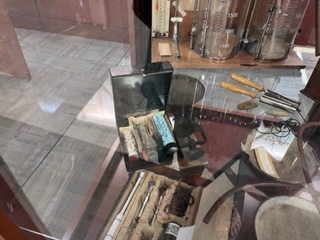
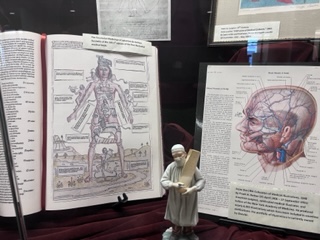
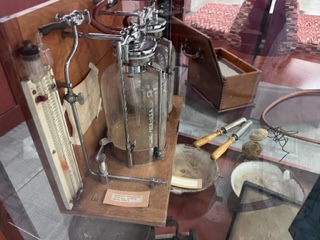
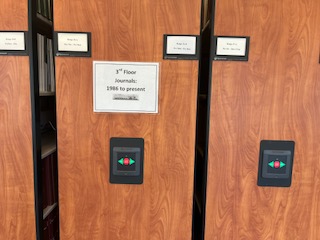
The collaboration spaces are phenomonal and I saw a couple of groups working in them. The collection of journals and periodicals is incredible. There are so many they use a special system to open and close the stacks. The Library of Congress classification system is used here and the vast majority of the collection is medical (No Lianne Moriarty books here, folks!). I spent the majority of my time here on the third floor, and somehow accidentally on purpose ended up in pediatric cardiology journals, got lost, got sad, and left. This is not a comfortable, welcoming, or hang out type of environment but I guess it helps people learn how to use those creepy instruments on the first floor.
References:
Ettarh, F. (2018, January 10). Vocational awe and librarianship: The lies we tell ourselves. In the Library with the Lead Pipe. https://www.inthelibrarywiththeleadpipe.org/2018/vocational-awe/
Rubin, R. E. and Rubin, R. G. (2020). Foundations of library and information science (5th ed.). ALA Neal-Schuman.
Photos: Tennille Cyphers (2022)
Did the library have study rooms? Were there computers to access the catalog? I guess it’s a good thing you ran into a student or you may have never been able to go in! VCU also had a set of the moving stack shelves – they are pretty neat and a brilliant use of space!
Yes, lots of study and collaboration rooms, primarily on the 2nd floor. There’s a computer lab on the first floor, for use only by EVMS students and faculty. WiFi is also only available to students and faculty.
I wonder what the reason would be for keeping it locked up like that, and open but not really open to the public? I’m glad you were able to get in and visit though!
I think this could turn into a very deep discussion! Honestly, I think it’s to limit access to information but in a covert way. I think medicine as a whole has been doing that forever and these institutions are a part of that system. I do acknowledge that a lot of what’s in there in specialized knowledge that may be difficult to understand-but that doesn’t mean the average person shouldn’t have access. Interestingly, as a business or individual, you can pay a yearly fee to be able to check out materials.
Your write-up of this library and then your anecdotal story of your visit to Boston really pulls on the heart strings. I love the fact that people are finding these libraries and are utilizing them, even when not a student there. This really helps us realize the goals of libraries.
Thanks, Todd. It really is very interesting the things you find when you wander in/around hospitals late at night. There are several libraries at Boston Children’s as well-one specifically dedicated to pediatric cardiology that I would peruse to kill time during the day. It is great that these collections exist and are “open to the public” though I wish the terms were expanded a bit…
How cool would it be for them to offer an Introduction to the Collection program a few times a year for the “layman”??
Sounds like an intimidating library that would have made me feel uncomfortable too. Are they open on weekends or during normal hours?
It looks like they’re open until 11 pm some days, 6 pm two nights a week and undisclosed hours to the public.
Yeah, it doesn’t sound like this is really “open to the public” at all. The outside is very appealing! Do you have to have a student badge to get in, then?
I’m sorry to hear about your personal experience with medical libraries. This can’t have been an easy visit for you, so thanks for informing us.
Thanks. It was a little cathartic, I think actually.
Hi Tennille – Thanks for sharing this library with us. It’s unfortunate that it’s not a welcoming, open space, especially since hospitals tend to be places high emotion. I imagine you are not the only person to end up looking into the library (by chance or on purpose), and hope that in the future the librarians there can make this space more open and inviting!